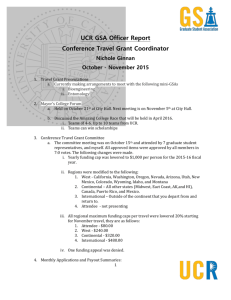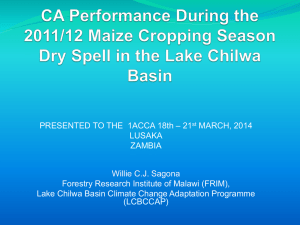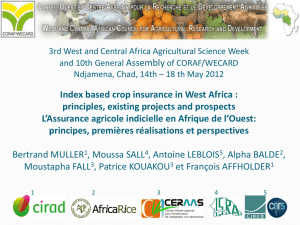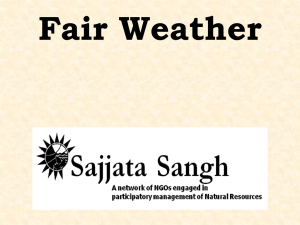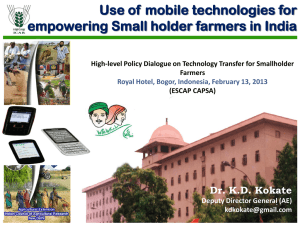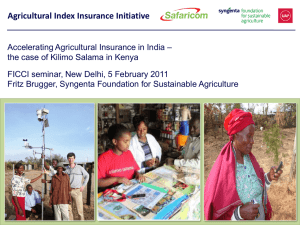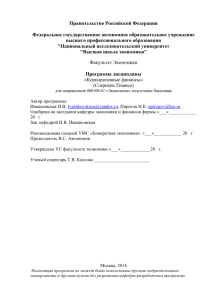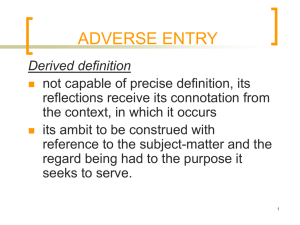mr. mapfumo
advertisement
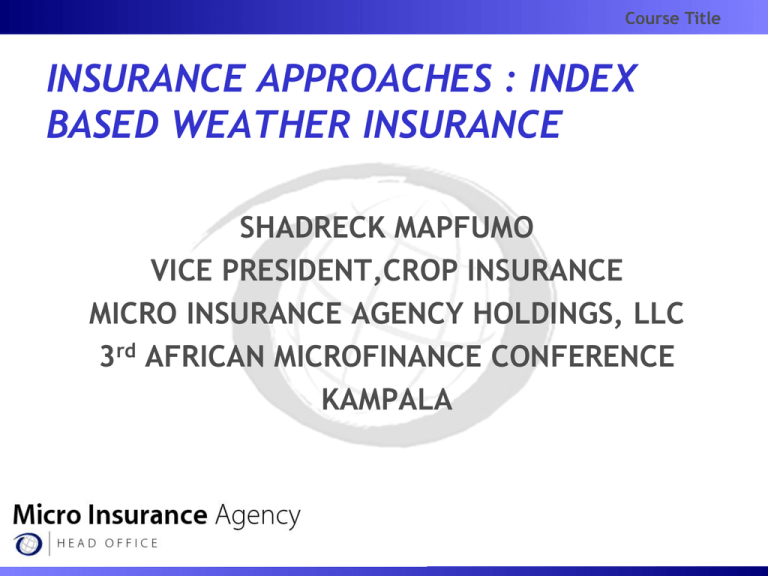
Course Title INSURANCE APPROACHES : INDEX BASED WEATHER INSURANCE SHADRECK MAPFUMO VICE PRESIDENT,CROP INSURANCE MICRO INSURANCE AGENCY HOLDINGS, LLC 3rd AFRICAN MICROFINANCE CONFERENCE KAMPALA Course Title Malawi Project Partners • • • • • • CRMG- WORLD BANK (Certain Slides ) MRFC OIBM NASFAM Malawi MET IRI, Columbia University PRESENTATION OVERVIEW Course Title Context How to Develop a Micro Level Weather Risk Management Program Timeline. Key Hurdles Conclusion Course Title CONTEXT RISKS IN AGRICULTURE Weather Related: Drought Flood Frost Hail Cyclone Course Title Non Weather Related: Displacement Civil Strife Economic Decline Price Collapse Pests Insurance only covers causes captured by index Course Title HOW FARMERS COPE WITH DROUGHT RISK • Minimize investment: local seeds, little/no fertilizer • Cover ground with straw to protect humidity (coffee) • Irrigate • Diversify: Plant Cassava as “drought insurance” • Accumulate livestock as “bank” for times of stress Food emergency camps 1 in 20 years (unpredictable) Food aid – some migration Insurance Intervention Soil (+asset) depletion Normal Yield Extra yield Frequency 1 in 7 1 in 4 1 in 2 1 in 4 Course Title TRADITIONAL VS. INDEX- BASED INSURANCE Multi-peril Crop Insurance High Administrative Costs Moral Hazard Adverse Selection Index-Based Weather Insurance Use weather parameteras a proxy for damage Objective triggers and structured rules for payouts Improved correlation between need and provision CHALLENGE Course Title Design an alternative, efficient and costeffective crop failure insurance program that can be easily reinsured and distributed to individual farmers: small, medium and large. DEVELOPING A PROGRAM Course Title Identify significant farmer exposure to weather Quantify the impact of adverse weather on their revenues Structure a contract that pays out when adverse weather occurs Execute contract in optimal form to reinsure the risk in the international markets DEVELOPING A PROGRAM I. Identify significant farmer exposure to weather II. Quantify the impact of adverse weather on their revenues III. Structure a contract that pays out when adverse weather occurs IV. Execute contract in optimal form to reinsure the risk in the international markets Course Title I.IDENTIFY THE RISK Course Title Location: Which regions are at risk to weather? º What are the weighting for each region’s contribution to risk? Period: What is the critical period? º Monthly, seasonal, annual, multi-year? Index: What weather measurement is the most accurate proxy for exposure? º º º º º Temperature, Rainfall, Snow, Frost etc. Average, Minimum, Maximum Cumulative Event Combination or compound or several factors CROP SENSITIVITY TO WEATHER *Maize yields are particularly sensitive to rainfall during the tasseling stage and the yield formation stage – rainfall during the latter phase determines the size of the maize grain 2% 2% 2% 2% 13% 13% 13% 13% 13% 13% 13% 1% 1% x Cumulative Rainfall in each decade = Maize Rainfall Index Weights and diagram taken from the FAO’s maize water requirement report* Course Title DEVELOPING A PROGRAM I. Identify significant farmer exposure to weather II. Quantify the impact of adverse weather on their revenues III. Structure a contract that pays out when adverse weather occurs IV. Execute contract in optimal form to reinsure the risk in the international markets Course Title II.QUANTIFY THE EXPOSURE Course Title Unit Exposure: What is the farmer’s weather exposure per unit of the defined index? º º What is the yield volume lost per unit index? Best year/worst year analysis, yield regression etc. What is the $ value lost per unit index? Expected market value, input/production costs Limit: What is the total amount of protection required per risk period? º º This may be the starting point for determining the total sum insured What are the objectives of the pilot program? DEVELOPING A PROGRAM I. Identify significant farmer exposure to weather II. Quantify the impact of adverse weather on their revenues III. Structure a contract that pays out when adverse weather occurs IV. Execute contract in optimal form to reinsure the risk in the international markets Course Title IIIa. STRUCTURE A PROGRAM III. STRUCTURE THE PRODUCT Course Title Type: Insurance at what level? º º º Farmer stand-alone insurance products Weather-indexed loans or credit Crop Loan Portfolio Insurance Retention: Define the trigger index level where weather protection begins º º How much risk does the farmer want to retain? Key to pricing and transfer Premium: How much can a farmers afford ? Payment terms for coverage (upfront, periodic etc.) Subsidised by lenders or government? Course Title A Standardized Approach To: Contract RECOMMENDED APPROACH TO CONTRACT DESIGN Design Balance simplicity that farmers and stakeholders can understand, with the complex dynamics that characterize water stress impact on crop yields: Easy to communicate to farmers and stakeholders Performs well from agro-meteorological perspective Provides required protection for all stakeholders at an affordable level Captures local conditions and environment Simple to replicate to other locations and crops so that programs are scalable Local ownership, so programs are sustainable Course Title EXAMPLE: LILONGWE CONTRACT, MAIZE 30 days 130mm 58 MKW/mm 5800 MKW Deficit Rainfall (mm) Phase 3: Trigger Level: Payout per mm: Maximum Payout: 40 days 25mm 1160 MKW/mm 5800 MKW Payout ($) Phase 2: Trigger Level: Payout per mm: Maximum Payout: Payout ($) 50 days 40mm 580 MKW/mm 5800 MKW Payout ($) Phase 1: Trigger Level: Payout per mm: Maximum Payout: Deficit Rainfall (mm) Deficit Rainfall (mm) PHASE 1 PHASE 2 PHASE 3 Sowing & Establishment Growth & Flowering Yield Formation to Harvest Sowing Window & Dynamic Start Date 10th November – 10 January: 25 mm in 10 days Cropping Calendar Final Insurance Payout = min (Max Payout, Phase 1 + 2 + 3 Payouts) DEVELOPING A PROGRAM I. Identify significant farmer exposure to weather II. Quantify the impact of adverse weather on their revenues III. Structure a contract that pays out when adverse weather occurs IV. Execute contract in optimal form to reinsure the risk in the international markets Course Title Course Title A Standardized Approach To: A STANDARDIZED APPROACH : IMPLEMENTATION Program Implementation Data International In-Country Data Reinsurance Company Reinsurance treaty Insurance Company/Association Bulk weather insurance contract Met Office Data Product Retailer: Bank/MFI/Cooperative/Input Supplier (Bundled) weather insurance contract Data Farmer/Farmer Groups Clear, well-defined responsibilities, product accounting practices and communication between all in-country stakeholders Course Title TIMELINE ? months 3 months X months PRODUCT DESIGN PRODUCT MARKETING PROTECTION PERIOD •Farmer Interviews •Distribution Partners •Interviews with specialists. •Product Education •Interviews with key stakeholders. •Data Procurement •Index Design • Product concept testing • Product documentation •Product Feedback •Weather Markets •Product Execution •Daily Monitoring 1 month SETTLEMENT •Settlement Calculation •Claims Paid KEY HURDLES Course Title Weather infrastructure. Basis Risk or “How good is this insurance?” Mismatch between coverage and actual result How can it be minimised? • • • • • Data Write contracts on stations near farmers Clever structuring Community-level risk pooling? Protection against catastrophic events Satellite data – NDVI, derived precipitation? or “Can we reinsure the risk?” Length of historical record - 30 years or more? Quality controlled, cleaned, enhanced? Reliable ongoing collection and reporting procedures? Third-party settlement data e.g. UKMO? CONCLUSION Course Title Weather insurance is not a panacea : It can only enhance existing agricultural supply chains and businesses, not create them It can help support expansion in rural finance and agriculture But must go hand in hand with investment in extension services, irrigation, strengthening of input and output markets etc. Course Title THANK YOU !


